PinotFile: 6.25 May 7, 2007
|
Make Mine Dijon PleasePinot Noir clones are genetically identical plants taken from a single mother vine cutting or bud. Pinot Noir selections (also called field or mass selections) are sourced from a vine that has multiple different parent vines. As the French love to point out, all Pinot Noir clones and selections planted in North America came from France. The original clones planted in California and Oregon are so called “mother” clones (often now referred to as heritage clones) and suitcase clones. The true history and source of many of the mother clones is shrouded in mystery. Many of the European cuttings of mother clones were brought to California in the 1850s and 1860s. Agoston Haraszthy traveled to Europe, including Burgundy in 1861, and brought back many vine cuttings, but it is unlikely he was the first to bring Pinot Noir to the New World. The Mt Eden clone was brought to California from Burgundy by Paul Masson in the 1890s. Louis Latour’s father supposedly gave him cuttings from Corton and Corton Charlemagne. Chalone would later purchase grape scion from Martin Ray who later owned Paul Masson’s vineyard, as did Dr. Stanley Hoffman for the HMR Vineyard in Paso Robles, and Dr. David Bruce in the Santa Cruz Mountains. In the early 1980s, Merry Edwards sent cuttings from a single Mt Eden vine to University of California Davis where it was named UCD 37. The Jackson clones (UCD 9,16) originated from experimental plantings in the town of Jackson in the Sierra Nevada region of California. The Wente clone/ selection is probably many clonal selections from early plantings in the Arroyo Seco region of Monterey County. The Swan clone (UCD 97) is a Pommard selection probably sourced from Burgundy. It was planted by Joseph Swan in the early 1970s. Most of Dehlinger’s Estate Vineyard is Swan clone. The Pommard clone (UCD 4,5,6) originated from cuttings Professor Harold Olmo imported from Chateau de Pommard in the 1940s. Olmo also developed the Martini clone (along with Louis Martini) from vine cuttings taken from Inglenook and subsequently planted at the Stanly Ranch in Carneros (UCD 13,15). The Wädenswil clone (UCD 1A,2A,3A) was imported from Switzerland in the 1950s. The Mariafeld clone (UCD 17,23) also came from Switzerland. Roederer clones (UCD 32,33,41) were introduced in 1984 after importation from Champagne. (The complete details of clonal history are confusing to say the least. John Haeger , author of North American Pinot Noir, does the best job of attempting to unravel the story.) Suitcase clones are cuttings that have been smuggled into the United States wrapped in wet newspaper and hidden in suitcases. There are many stories of the illicit importation of cuttings from Domaine Romanee- Conti and some are undoubtedly true (Calera, Swan, Rochioli, Pisoni). Because of the illegality of such smuggling, the true extent of suitcase clones planted in North America will never be known. In the 1970s and 1980s, the heritage clones were the workhorses in Pinot Noir vineyards in Oregon and California. An event in 1984, however, dramatically changed the course of Pinot Noir winegrowing in the United States. Dr. David Heatherbell, Professor of Enology at Oregon State University, convinced Dr. Raymond Bernard of France to share his Pinot Noir and Chardonnay clones with Oregon. Bernard had been at work at the Dijon office of the French Ministry of Agriculture since the 1960s, selecting clones of Pinot Noir and Chardonnay that would improve the quality of wines in Burgundy. The laboratory technicians at Oregon State University nicknamed the imported cuttings “Dijon clones” after the return address on the shipping container, and the name has become part of viticulture lexicon and widely accepted. Most of the original budwood (for example, 113, 114, 115) came from Domaine Ponsot in Morey-St.-Denis. There are now nearly 50 recognized clones of Pinot Noir in Dijon, France, 15 of which are significantly propagated. There may be as many as 1000 clones of Pinot Noir world wide (Cabernet Sauvignon, in contrast, has only 12 identifiable clones). The planting of Dijon clones in Oregon and California took off in the 1990s. “Make mine Dijon please” became the catch phrase. The Dijon clones became quickly popular because of their smaller berry size, resulting in more intense colors and tannins and darker tones in their aromatics and flavors. Because the clones ripened earlier, they were ideally matched to the marginal sites so desirable for growers of Pinot Noir. Clone 115 has become the most widely planted. Multiple Dijon clones are often blended and still other Dijon clones can make a complete wine on their own (for example 777). Heritage clones are also frequently blended with Dijon clones. Many winemakers are high on Dijon clones, but others are saddened to see the de-emphasis on heritage clones, pointing out the diverse and unique nuances that only they bring to Pinot Noir. Pommard, for example, has a meaty/gamey edge to its plumy fruits. If there is one thing we have learned in the last 10-15 years, it is that the proper clones must be planted on the appropriate site. In some vineyards, heritage clones perform better than Dijon clones and vice versa. As John Haeger said, “The ’best’ clones can never compensate for a poor site, nor will ’wrong’ clones completely obscure the potential of a great site.” Each of the Dijon clones has distinguishing aromatic, flavor, structural and tannic profiles. Some generalizations may be helpful in understanding why certain clones are blended or bottled on their own. The “teens” clones (113,114,115,116,117) are lighter, brighter and more forward with typically more red fruits (cherry, raspberry). 667 and 777 are darker, fleshier, more structured with emphasis on black fruits (black raspberry, black cherry, cola, spice). The newest clones, 828 and 943, have only been in the ground a couple of years. 113 (1971): most elegant of teen series with prominent floral aromatic components, terrific texture, extractable but slightly masked tannins (114 and 115 have more power) 114 (1971): dark color, rich aroma, good structure, tannic 115 (1971): purplish, superior aromas, good structure, notable tannins, long and will age; can make an excellent and complete wine on its own. 375 (1974): average color, quality aromas, elegant 667 (1980): a workhorse clone; good color, hi-tone aromas, ripe black sweet fruit, fleshy, firmness, thick but soft tannins 777 (1981): more consistent than 667; very aromatic, denser and complex with earthy notes, black fruit, cherry, cassis, leather, tobacco; almost Cabernet-like.
Elk Prairie Vineyard: Native American Pinot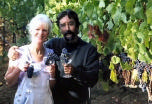 The site is a unique microclimate with warm days tempered by morning fog rising from the Eel River below. After harvesting the grapes at Elk Prarie, the wines are fermented in small 1/2 ton macro bins located outdoors in the shade of the winery. The cap is punched down by hand. Aging is in 30% new French oak. Handling is minimized and the wines are unfined and unfiltered. Production is about 700 cases per year. Some grapes are sold to nearby Briceland Vineyards and Woodenhead who both bottle a vineyard-designate Elk Prairie Pinot Noir. All of the wines feature some earthiness, darker fruits, and good acidity.
 2004 Elk Prairie Vineyard Humboldt County Pinot Noir 13.0% alc. $22. · The nose is more red fruits - raspberries and strawberries and the flavors trend toward black raspberry. There is appealing notes of earth and minerality. The lingering finish features taut and dusty tannins. A very nice Pinot.
2002 Briceland Vineyards Elk Prairie Vineyard Humboldt County Pinot Noir 14.7% alc.. Briceland Vineyards is located at 5959 Briceland Rd, Redway, CA 95560. 707-923-2429. Tasting by appointment. Several white varietals and sparkling wine are also produced. · The nose is oak-driven with flashes of heat. A decent core of fruit features dark cherries and plums with a kiss of earth and shrooms. The finish is clean and bright.
2002 Woodenhead Elk Prairie Vineyard Humboldt County Pinot Noir 14.1% alc. Woodenhead is a small artisanal producer of Pinot Noir and Zinfandel sourced primarily from vineyards in the Russian River Valley and Anderson Valley. The owner and winemaker is Nikolai Stez. The phone is 707-887-2703. The wines are offered on the website at www.woodenheadwine.com. · The aromas trump the flavors here. The perfume of deep, dark cherries and spicy oak draw you in. Blackberry and black cherry compose the flavor profile accented with a char note. A touch of phenolic bitterness mars the finish.
2002 Elk Prairie Vineyard Humboldt County Pinot Noir 13.2% alc., $22. · The distinctive aromatics feature black raspberry, raisin and oak. The dark fruit core is highlighted by herbs and mocha and the finish is brisk. Some slight oxidation is creeping in.
Elk Prairie Vineyard is located at 11544 Dyerville Loop Road, Myers Flat, CA 95554. The phone is 707-943-3498. The wines may be ordered from the website at www.elkprairievineyard.com.
Gypsy Canyon Winery a TraditionalistOver a 100 years ago, the first known woman wine grower in California, Dona Marcelina Felix Dominguez, grew Mission vines on her Santa Barbara property. The vines survived, and when Deborah Hall and her late husband, William, brought the property in 1994, they discovered these vines under a heavy cover of brush. They originally thought the vines were Zinfandel, and sold them as such to other vintners. DNA testing at University of California Davis later revealed that they were Mission vines. Mission vines were brought into California in 1767 by Spanish Padres from Mexico who established a chain of missions from San Diego to Sonoma from 1767 to 1833. Deborah’s ancient Mission vineyard of three acres is part of only ten acres still growing in California. She has named the ancient Mission vineyard Dona Marcelina’s Vineyard and today, it is the oldest producing vineyard in Santa Barbara County. Using a recipe written in 1891 by Emile Vache, Deborah crafts a Gypsy Canyon Ancient Vine Angelica, a rich, fortified dessert wine from the Mission grapes. 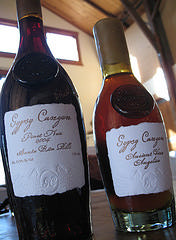 The original Gypsy Canyon property was 290 acres and included an 1800s farmhouse. After Deborah’s husband passed away in 1997, she sold 160 acres (with 18 acres of vineyards) and kept 130 acres with 12 acres of vineyards to herself. Her original intent when she bought the property was to produce Pinot Noir. There are 4 acres of clone 115 and 777 Pinot Noir and some Pinot Gris planted on the Gypsy Canyon Santa Rita Creek Vineyard. The initial winemaker was Norm Yost (Flying Goat) who crafts the wines in the Lompoc “ghetto.” The site has an exceptionally cool microclimate compared to other vineyard sites in the Ste Rita Hills AVA. Farming is largely by hand and is both organic and biodynamic. The first release of Pinot Noir was in 2004. The whole Gypsy Canyon package is quite traditional and striking. Deborah uses a hand blown glass bottle of historical shape with an embossed glass seal, a handmade paper label, and a beeswax seal. Each bottle is numbered and signed by Deborah Hall. All of this historical esthetic adds to the appeal of the wine inside. I must warn you, however, the bottle is fragile. While inserting a bottle recently into my wine cabinet, I used gentle force to find a space. The bottle broke, spilling the sweet-perfumed liquid into my cabinet and onto the floor. At $75, I blurt out several expletives.
 2005 Gypsy Canyon Winery Lot 2 Santa Rita Creek Vineyard Santa Rita Hills Pinot Noir 14.0% alc., < 18 cases, $75. Aged 15 months in 50% new French oak. Hand bottled in January, 2007. · This is a very elegant, smooth and polished Pinot Noir. The color is more mahogany than violet. The nose is a bit rustic with brown sugar-coated cherries and a hint of port. The cherry fruit is complemented by gregarious spice, cinnamon and a lively finish which displays gossamer tannins. Very appealing. Delicious the next day from an uncorked bottle.
Gypsy Canyon Winery wines are primarily sold through a mailing list at www.gypsycanyon.com. Tasting of Gypsy Canyon wines with cheese is available by appointment ($25). Stunning hand-blown magnums of Pinot Noir are available ($190). There is a second Fall Release (October) of Santa Rita Creek Vineyard Pinot Noir. The Angelica (552 bottles) is $120 (375 ml).
Pinot Freak Brian LoringI first wrote about self-admitted “pinot freak” and owner of Loring Wine Company, Brain Loring, in 2002 when his wines were receiving considerable press and interest. While in college, he worked at a wine store in Southern California where one of the owners was a Burgundy fanatic. Brian’s first experiences with Burgundy were from producers he quickly admired like Domaine Dujac, Henri Jayer and Domaine Romanee-Conti (who wouldn’t?). Early safaris into the domestic Pinot Noir jungle of the 1980s were unsatisfying until he tried some Calera. Eventually he came to understand and enjoy other California Pinot Noirs like Williams Selyem, Chalone and Sanford. But it was the friendship he developed with winemaker Norm Beko of Cottonwood Canyon Winery that got him started in the wine business. While participating in the 1997 crush, he made two barrels of his own Pinot Noir and the Loring Wine Company was hatched. The name was a homage to Josh Jensen and the Calera Wine Company . Brian was to be one of the first boutique Pinot Noir producers to enter the field cold so to speak (he was a software engineer). Unimpressed by his own good fortune and success, he has shared his enthusiasm and knowledge freely, and inspired a number of other pinot freaks such as Greg Piatigorski (Alcina Cellars), Jamie Kutch (Kutch Wines), and Andrew Vingiello (A.P. Vin). 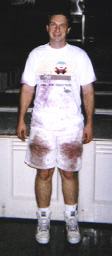 The Brian Loring style is representative of the New World or “Caliesque” Pinot Noirs in that the wines are dark-hued, bursting with showy and sappy fruit, full-bodied in structure, possessing a toasted oak character from the use of plentiful medium toast new French oak, and in some cases, firm tannins. The normally significant alcohol levels in Loring Wine Company wines have been moderated in the latest 2005 vintage releases (13.2% - 14.9%). Recently I had the opportunity to taste through several of Brian’s 2005 releases. The wines are bottled under screw tops and are not intended for long-term cellaring. However, some of the wines benefit greatly from decanting or exposure to air for a few hours ( which results in less noticeable tannins and smoother finishes), and some have the cohunes to last several years. 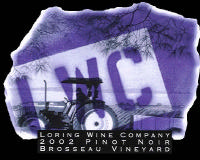
2005 Loring Wine Company Russell Family Vineyard Paso Robles Pinot Noir 14.9% alc., 175 cases, $40. The grapes come from a cool and westerly vineyard. · This wine has an arsenal of red cherry and earthy aromas and flavors with noticeable oak in the background throughout. The texture is soft and sexy. There are moderate tannins on the long finish which smooth out with a couple hours of air time.
2005 Loring Wine Company Cargasacchi Vineyard Santa Rita Hills Pinot Noir 13.7% alc., 400 cases, $45. · The complex nose features wet leaf, mushroom, tea and toast. There is plenty of stuffing but the wine comes off as quite demure and feminine. The mid palate erupts with red fruit, spice (cardamom) and tea notes leading to a finish of oak-tinged cherries and coating tannins. Still a little closed but with great potential.
2005 Loring Wine Company Clos Pepe Vineyard Santa Rita Hills Pinot Noir 14.1% alc., 800 cases, $45. · This wine has the darkest color of the lineup. The nose is terrific with notes of crushed red cherries, cocoa, and vanillin. After two hours, the nose was more cherry vanilla cola with a hint of alcohol. This Pinot is packed and stacked with fruit with plush black raspberries in the middle and oaked tart cherries at the end. The tannins are under wraps and the texture is downy. Prodigious wine.
2005 Loring Wine Company Rancho Ontiveros Vineyard Santa Maria Valley Pinot Noir 13.2% alc., 400 cases, $45. · This is the most elegant wine in the lineup. Terrific aromatics bring plenty of hi-tone cherry to the front. Both red and black fruits are evident in the structured core. The fruit is embraced by toasty oak on a finish featuring fine-grained tannins.
Loring Wine Company Pinot Noir 2005 lineup also included the 2005 Loring Wine Company Brosseau Vineyard Chalone AVA Pinot Noir ($45), 2005 Loring Wine Company Durell Vineyard Sonoma Valley Pinot Noir ($45), 2005 Loring Wine Company Keefer Ranch Green Valley Pinot Noir ($54), 2005 Loring Wine Company Rosella’s Vineyard Santa Lucia Highlands Pinot Noir ($45), 2005 Loring Wine Company Garys’ Vineyard Santa Lucia Highlands Pinot Noir ($45), 2005 Loring Wine Company Naylor Dry Hole Chalone AVA Pinot Noir ($57, 75 cases), and the 2005 Loring Wine Company “Hungry Like the Llama” Pinot Noir ($60, a blend of 3 to 4 barrels from multiple appellations). In 2006 (the 2006 Pinot Noirs will be released in October, 2007), Brian has added Graham Vineyard (Green Valley) and Tank Mesa Vineyard (Santa Rita Hills). The wines are sold through a mailing list at www.loringwinecompany.com. The prices above are lowest retail prices for wines currently in the market. Shipping is free when ordered through the mailing list. There is also widespread retail distribution and placement in many prominent restaurants countrywide. The winery is located at 1601 W Central Ave, Unit F, Lompoc, CA 93436. Tasting by appointment.
Vinturi Wine Aerator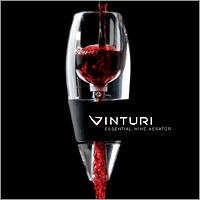 Vinturi is a new innovative wine aerator that reportedly accelerates the breathing process, allowing consumers to enjoy their wine from the first sip, rather than waiting a couple of hours or more. The device is held over a glass as wine is poured through. Vinturi draws in and mixes the proper amount of air for the right amount of time, essentially allowing the wine to breathe instantly. Venturi applies Bernoulli’s principle, which states that as the speed of a moving fluid increases, the pressure within the fluid decreases. When wine is poured in the Vinturi, its design creates an increase in the wine’s velocity and a decrease in its pressure. This pressure difference draws in air, which is mixed with wine for perfect aeration. The Vinturi inventor is Rio Sabadicci. Double blind studies conducted by Vinquiry Wine Analytics in Napa confirmed that Vinturi produced better overall aroma and flavor intensity and mouth feel and a smoother finish. Vinturi is endorsed and used at more than two dozen Napa Valley wineries including Acacia Vineyard, Bouchaine, Hope and Grace Wines and Robert Mondavi Winery. Suggested retail price is $39.95 at www.vinturi.com.
A Glass of Pinot and a Good Book
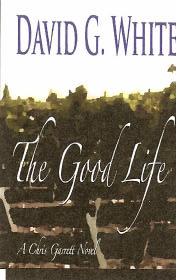 The Good Life, A Chris Garrett Novel. David G. White, Harmon and White Publishing, Napa, CA, 272 pp, hardcover, $24.95. Available at Amazon.com, book retailers and by phone at 707-213-1202. What a great read for wine aficionados - a good murder mystery written by a winemaker. The author, David G. White, graduated from the Professional Writing Program at University of Southern California. He also assists in winemaking at Carneros della Notte in the Napa Valley. When winemaker Chris Garrett discovers his mentor and boss, Vic Maranda, has drowned in a vat of fermenting wine, he immediately rejects the idea that his death was an accident. Using his winemaking experience to build his case and discover clues, he investigates the murder with a friend and Deputy Sheriff, Jeff Beckwell. His search is fraught with danger and mysterious characters, escaping death when someone tries to run him off the road on Spring Mountain Road. Pour a good glass of Pinot and settle in for some entertaining storytelling sprinkled with the lexicon and life of winemaking in the Napa Valley. 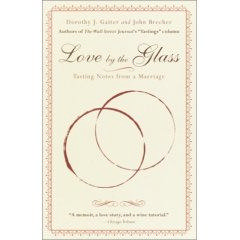 Love by the Glass, Tasting Notes from a Marriage. Dorothy J. Gaiter and John Brecher (authors of The Wall Street Journal’s “Tastings” column. Random House Trade Paperbacks, New York, 316 pp, $12.95. This is a captivating tale of two wine lovers who become husband and wife. Their life together is told around events shared with wine with instructive insight into the many bottles they have enjoyed. Beginning with André Cold Duck, which they drank on their first date, and later through many train trips highlighted by Taittinger Champagne, theirs is a gifted romance that anyone who has a passion for wine can appreciate. Be forewarned that their approach to wine is unpretentious, so if the reader harbors any smugness about common wines, they might be disappointed. As the book concludes, “It’s just wine. It’s not life. It’s just a wonderful part of everyday life. Relax and enjoy it.” The couple still writes the “Tastings” column in The Wall Street Journal and I look forward to reading it every week. California Wine Country, A Sunset Field Guide. Peter Fish and Sara Schneider, Sunset Books, Menlo Park, CA, 160 pp, paperback, $19.95. This is a handy guide to each of the major California wine regions from Mendocino in the north to Baja in the south. Each of the chapters has a short description of the major wineries (alas, the small, appointment-only producers are omitted and the tasting room hours of wineries listed are absent), things to do, where to eat, places to stay, and decent, although not extensive maps of the winery locations. It is written primarily for newbies to wine touring, but it has something for everyone and fits neatly into your auto’s glove compartment.
The Sonoma Wine JournalI picked up the inaugural issue of The Sonoma Wine Journal recently. Scheduled to be published on a bimonthly or quarterly basis, it is the work of several collaborating wine enthusiasts. Each issue will contain notes from one or more tastings focused on a particular varietal or grape-growing area but the thrust is wines from Sonoma County. For example, in Issue 1, there is a report of an extensive tasting of ultra-premium California Chardonnays. There are ten pages of wine reviews with extensive notes and scores covering many different Sonoma-grown varietals. The journal is free and still a work in progress, but shows great promise. For further information, contact the authors at their e-mail address: sonamwinejournal@gmail.com.
Kings Hill Cellars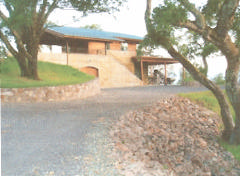 The wine enthusiast often feels like he or she has not been fully satiated until they make their own wine. More and more opportunities are cropping up to allow novices to become winemakers. Kings Hill Cellars is a new entrant into the business, but unlike firms that produce wine for customers, Kings Hill Cellars provides members with hands-on experience and the opportunity to participate in most phases of production starting with sorting and de-stemming, then crushing and pressing, and finally to blending and bottling. An in-house graphic artist designs logos and private labels. The winery is a state-of-the-art facility that is specifically designed to make small lots of handcrafted wines. The winery crushed its first fruit in 2006 with friends and family, and now is making memberships available to others. Members have the option of making a 30 or 60 gallon barrel of wine that yields 12 or 24 cases respectively. The price includes grapes from mainly North Coast vineyards, a winemaking tutorial, consultation as needed, the use of equipment, staff cellar practices (racking, topping and monitoring), and standard packaging (750 ml bottles, cases, corks, and wine labels). Kings Hill Cellars is owned and managed by Lindsay Austin, an entrepreneur and former business executive who moved to the wine country in 2001. Austin hired winemaker Richard Mansfield to help design the facility and Mansfield assists members through all critical steps, leaving them free to learn and enjoy the process. Kings Hill Cellars also accommodates small vineyard owners interested in making wine from their own grapes. Kings Hill Cellars is located at 3404 Kings Hill Road, Santa Rosa, CA. See www.kingshillcellars.com for contact information and additional details. |